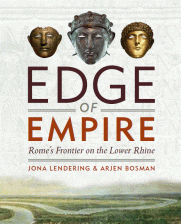Rosemary Sutcliff’s The Eagle of the Ninth (1954) is one of the most charming children’s historical novels I know. It tells the story of a young Roman officer, Marcus Aquila, who can no longer serve in the army because he is wounded, and decides to look for the eagle standard of the Ninth Legion Hispana. According to Sutcliff, this legion was destroyed in c.117 by Caledonian tribes in what is now Scotland – in 1954 a common hypothesis.
Indeed, there is no evidence that the Ninth was in Britain in the second century, but that does not mean that it was annihilated. It was almost certainly transferred to Nijmegen in Germania Inferior (on the Lower Rhine), where it was in the 120s. One of the finds that prove this, is a metal object found in Ewijk, a bit west of Nijmegen, now in the Valkhof Museum. The fact that we know the names of several high officers of the Ninth who can not have served earlier than 122 (e.g., Lucius Aemilius Karus, governor of Arabia in 142/143), is another indication that the legion was not destroyed but transferred.
It is also certain that this unit no longer existed during the reign of the emperor Marcus Aurelius (161-180), because it is not mentioned in a list of legions from that age. Perhaps, it had been destroyed by the Jews during the revolt of Bar Kochba (132-136); perhaps it is identical to the unit that was destroyed by the Parthians in 161 (Lucian, Alexander 27). We simply do not know. What we do know, however, is that a movie has been announced about Rosemary Sutcliffe’s lovely book – and to be honest, this time fiction is far better than facts.
Literature
- Duncan Campbell, “The fate of the Ninth“, in: Ancient Warfare 4.5 (2010) 48-53
- Jan Kees Haalebos, “Römische Truppen in Nijmegen”, in: Yann Le Bohec, Les légions de Rome sous le Haut-Empire (2000 Lyon) 465-489



 Posted by Jona Lendering
Posted by Jona Lendering 

 Subscribe to feed
Subscribe to feed